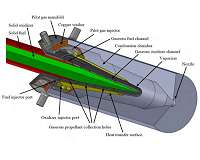There can’t be many ideas that beat the crazy yet ingenious idea of a rocket engine that actually uses part of the fuselage for fuel! Typically a rocket will utilise multiple stages so that excess weight can be jetisoned allowing the rocket to be as efficient as possible. Now a team in Scotland is working on a rocket engine that actually consumes part of its body to use as fuel, reducing weight and providing even more thrust so that greater payloads can be used.
Rockets go back thousands of years from the earliest rocket propelled arrows used by the Mongolian empire to the mighty Saturn V rocket that took Apollo astronauts to the Moon, the principle has remained largely the same. Take a fuel, cram it inside a container of some sort, ignite it in some way and you can use it to propel something forwards or upwards… or actually backwards too now I think about it.

Things are changing though. A team from the James Watt School of Engineering at University of Glasgow and led by Professor Patrick Harkness have developed the self-eating rocket engine! When the ‘autophage’ (from the latin for self-eating) fires it consumes part of its own body for fuel.
It’s really quite an ingenious concept, essentially some fuel is stored up inside the rocket chamber itself. As the engine fires, some of the heat melts through the plastic of its own fuselage and as the plastic melts, it is fed into the chamber as fuel to suplement the usual liquid propellant.
Using the rocket chamber itself as fuel means less fuel has to be carried and the mass saving can be used up by more massive payloads. There are further benefits too, as the rocket chamber is used in the combustion it will reduce the chances of space debris.
The idea is not a new one though since the idea of a self-eating rocket was first discussed just over 80 years ago. The team from Glasgow have taken the concept a step further though by building one! The container was made out of polyethylene plastic which would burn as suplementary fuel along side the regular liquid propellant, a mix of gaseous oxygen and liquid propane.
They succesfully fired the engine that they have called Ouroborous-3 which produced 100 newtons of thrust. The thrust was stable even through the autophage stage when the plastic case was providing a fifth of the total propellant used.
Previous rocket tech used a solid propellant, for example the solid boosters on the side of the space shuttle and once this stuff was lit, whether you liked it or not, you were going in to space. This new design is controllable, indeed the team demonstrated how it was capable of being restarted, throttled and pulsed in an on/off pattern, all of which are necessary for an efficient rocket enginge.
Source : Self-Eating Rocket Could Help UK Take a Big Bite of Space Industry

